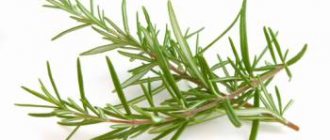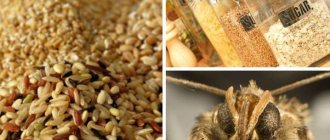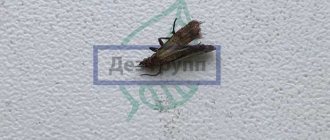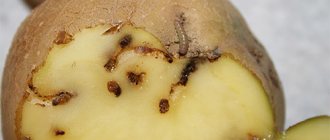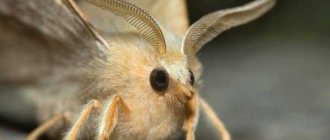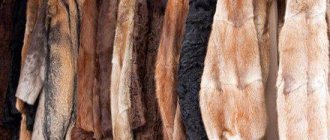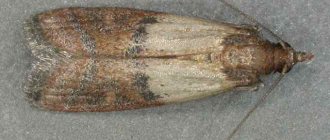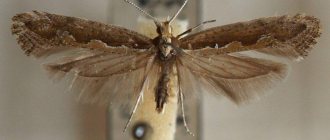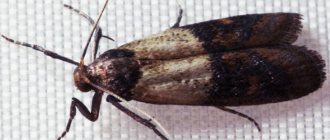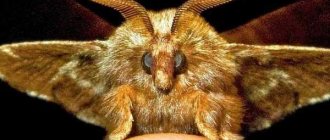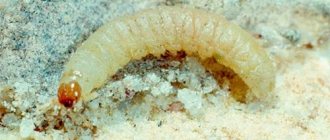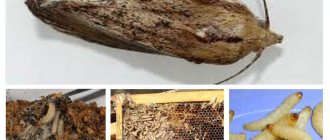Clothes and kitchen moths, or as they are also called - food moths, are the most common household pests that are found in the home. They tend to hide well, so insects can only be discovered when they are disturbed. Therefore, the owners learn about the extensive infestation only after the moths have already damaged woolen fabric, valuable fur or food products that can only be thrown away.
In this article, we will remind our readers of the main differences between moths and other types of completely harmless insects, briefly mention the life cycle of these insects, and also tell you how to get rid of clothes moths in your wardrobe.
How to distinguish between food and clothes moths
Clothes moths are usually more common than food moths. Their appearance is very similar, with the exception of some features identifying the species. Adult clothes moths are often golden in color with reddish hairs on the top of the head. Also, a row of golden hairs border the insect's wings, which have a span of about 1 cm. Since these pests are blinded by daylight, they are more often found sitting in dark areas of the closet or behind it.
Clothes moth
Clothes moths should not be confused with insects that parasitize food. This species tends to be much smaller in size and has a darker brownish-gray color. At rest, the insects are about 0.5 cm long, while most clothing pests are much larger.
Both species usually only fly around the immediate area where the infestation has occurred. In addition, they are characterized by a unique flight pattern. Fluttering and spiraling movements are the main distinguishing features of these gray butterflies from other species of nocturnal insects.
The larvae of both species are virtually identical, except that this stage of the clothes moth's life cycle always spins a fine, silky web as they feed. Subsequently, this web serves as the basis for weaving a future cocoon.
Among other things, clothes moth excrement may contain dyes from fabric fibers, which they accepted as food. Therefore, the presence of colored sand grains should indicate the presence of this species.
food moth
How to protect clothes
To protect your wardrobe from parasites, it is important to know what repels moths from clothes.
It is advisable to use folk remedies that do not harm things, human health, or animals.
You can save and protect clothes from moths using the following methods:
- Powders. The assortment of specialized stores includes powders based on substances that repel parasites. Such powders do not harm humans, and to obtain the desired effect, it is enough to place a bag of the substance in the closet.
- You can make powders that will help protect your wardrobe from pest invasions yourself. To do this, collect wormwood or lavender herbs, dry, grind, and place in the closet. Plant raw materials do not harm humans and do not damage the appearance of clothing.
Moth caterpillars prefer to feed on natural fur, which jeopardizes an expensive wardrobe item - fur coats. To avoid the appearance of pests, before putting the item away for summer storage, it is recommended to put the above products in its pockets.
It is important to remember that regular cleaning and washing of clothes will help prevent pests.
You also need to periodically ventilate your wardrobe, wardrobes, and apartment. This measure will help identify pests and reduce their numbers.
Life cycle
Females of both species lay an average of 40 to 50 eggs over a 2-3 week period and die once the laying process is complete. Males live longer than females and continue to mate for the remainder of their lives. The eggs hatch within 4 to 10 days, provided environmental conditions are favorable.
In total, clothes moth larvae molt from 5 to 45 times, depending on the temperature in the room and the type of food available. The larval period lasts from 35 days to 2.5 years. It is during this period that the greatest damage from insects is observed.
Moth larvae are shiny white, and their head capsules are dark in color. As they feed, the worm-like insects rotate, simultaneously producing a web in which they gradually envelop themselves. When the larvae are ready to pupate, they crawl away from their food source to find a deeper crevice, crawl into it and the pupation process begins.
Pupation lasts from 8 to 10 days in summer and from 3 to 4 weeks in winter. Heated buildings allow moths to continue to develop during the winter months. Typically, the time for development from egg to egg is four to six months, with an average of two generations per year.
Peculiarities
An adult moth reaches 9 mm in length in the photo. Its color is quite inconspicuous, having a light yellow or straw color. Indoor flights are performed by males. Female insects have wings, but they never use them. Usually the female is in one place; for fertilization, the male finds her on his own. The moth then lays eggs, the larvae of which are the main pest.
Damage
The larval stage of the insect is the destructive stage of the moth's life. Insects feed on the wool of outerwear, carpets and rugs, as well as upholstery of upholstered furniture, furs, animal hair, felt pads in musical instruments and even fishmeal, which is found in abundance in fish food.
Moths will eat synthetic or cotton blends if these fabrics also contain wool. In addition, the pest larvae can also use cotton fibers to make a pupal base.
Characteristic damage usually appears in hidden places, for example, under collars or cuffs of clothing, in the crevices of upholstered furniture, as well as on carpets, some of which lie under furniture. It is worth noting that fabrics contaminated by food, sweat or urine stains are more susceptible to damage by pests due to their attractive aroma.
The real harm of moths
Damage from moths
When a moth is in the larval stage, it hurts more. It actively eats and destroys the structure of things and clothing until they become completely unusable. The food grade spoils cereals, flour and can even settle in animal feed. Interestingly, moth larvae can also ruin synthetic fabrics if they contain even a very small amount of wool. Parasites show special “love” for cotton fabrics, using cotton fibers as building material for pupae. Larval lesions are usually hidden and not immediately noticeable. Moths often grow in fabrics that are contaminated with food debris or that have not been washed for a long time, and retain the odor of sweat and other human body secretions.
How to get rid of clothes moths
Methods to control moth populations include periodic dry cleaning, laundering, proper storage, freezing, heating, fumigation, or the use of insecticides. Maintaining low humidity levels inside buildings creates an environment that is not conducive to moth development.
Room walls that don't have numerous tiny cracks and crevices will also encourage fewer pest infestations. Effective practices of good and meticulous housekeeping are essential. It is also important to regularly monitor long-term stored fabrics and the inner surface of wardrobes, preventing their first damage. This approach makes it possible to take action when the infection has not reached significant levels.
Reproduction
Males look for females by a specific smell. Just 4 hours after mating, the insect gives birth to a new generation. Eggs are laid in portions, one clutch reaches 60 eggs. Pests have no seasonality in development and reproduction. Butterflies also hatch unevenly. The most optimal temperature for rapid reproduction of the pest varies from 15 to 30 degrees Celsius. The higher the temperature in the living room, the faster the larvae hatch from the eggs.
Regular monitoring
In order to check for the presence of pests, the first thing you need to pay attention to is whether there are threads of cobwebs in hidden parts of clothing. It is also possible that there are tubes left behind after insects pupate. The area where these tubes are most common tends to have a lot of damaged clothing fibers and insect feces. The same picture can be observed in fur items, where, among other things, baldness can be observed, and when lightly tugging on the remaining fur, it will separate in large clumps.
Preventing or reducing infestations
Periodically cleaning "danger" areas in the home that may harbor moths can completely prevent the insects from appearing. These areas include not only hidden areas on woolen clothing, but also areas outside the closet itself, such as under heavy pieces of furniture, along baseboards and in cracks where hair, dog hair and other debris accumulate.
It is worth paying attention to the space behind the heating radiators and inside the ventilation openings.
A vacuum cleaner is the best tool for most basic methods of such processing. After using the device in areas known to be infested, the contents of the bag should be removed as quickly as possible from the home, since there may be many eggs, larvae or adults inside that can quickly return to the living environment.
Moths may initially establish themselves on woolen items or wool scraps that have been stored for long periods of time. In addition to storing woolen items properly, they should be periodically exposed to the sun and cleaned most thoroughly, especially along seams, inside folds and pockets. A natural fiber brush removes eggs and exposes larvae. In addition, the larvae do not like bright light, so they themselves will try to fall off the clothes as soon as possible.
If the infestation is observed in a closet, be sure to remove all clothing and fabrics stored inside. You should then thoroughly vacuum and wash all interior surfaces, especially cracks and crevices, before returning clean items. Powdered insecticides containing pyrethroids or pyrethrins, such as 0.05% Deltamethrin or 1% Pyrethrin, can be applied to cracks and crevices. Before using chemicals, you should always comply with the requirements indicated on the label.
Species living in rooms
Species of moths that live in houses and spoil clothes and food are called indoor moths. In appearance they differ little from each other. The following types of house moths are distinguished:
Clothes moth
These are butterflies with yellowish wings that have no pattern. Their wingspan is 9 mm. Insects infest woolen fabrics and knitwear. Sometimes clothes moths also damage semi-synthetic materials, but with such feeding, the development of the larvae occurs much more slowly.
Male moths are active and capable of flying quite long distances. Females fly poorly and move by flitting from place to place. Pregnant females hardly move and lead a secretive lifestyle.
Caterpillars are attached to clothing using covers made from their secretions. They eat holes in the tissues that are difficult to repair. Damage is difficult to notice at first glance, since pests do not touch the top layer of the material.
Fur coat
This variety can ruin an expensive natural fur coat in a short time. Butterflies have shiny dark wings with black dots, their wingspan is from 14 to 15 mm. The white larvae look like worms.
The fur moth feeds on clothing made from natural materials. With sharp jaws, like scissors, the caterpillars trim the wool on fur products, grind it and eat it. To get from the feeding site to the nest, they cut winding tunnels. In this way, numerous tracks of trimmed fur are formed on a fur coat or hat.
Furniture
This is a butterfly with inconspicuous wings of a golden hue. Its larvae eat winding tunnels in upholstered furniture. First, they eat the hair on the upholstery of seats and backs, then they crawl to the surface and gnaw the furniture upholstery.
The larvae develop into pupae on the undersides of chairs and sofas. A lot of pupated insects accumulate there. The maturation period of the larvae depends on how complete their nutrition was. On food rich in proteins, caterpillars develop quickly and turn into adult butterflies within a month.
Adults reproduce intensively. Female furniture moths are fertile, their clutches contain up to 200 eggs. They lay them on the surfaces of furniture so that the hatching larvae have food.
Food
This moth is sometimes called granary moth. It looks like furniture, which is why these two types are sometimes confused. Food moths are found in flour, cereals, sugar, and dried fruits that have been stored for too long or incorrectly. Insects are sometimes found in bags of dry cat and dog food. They do not damage fabrics or furniture. Food moths also live in nature, where they feed on nuts and dried fruits of trees. It is common in the steppe and forest-steppe zones.
This insect is up to 8 mm long. A moth sitting with its wings folded is difficult to notice and is often mistaken for a protrusion on the surface. Granary moth caterpillars are light-colored, with a yellowish or pinkish tint. Before turning into pupae, they are sedentary and lead a secretive lifestyle. Before pupation, the caterpillars crawl out of their shelters to the surface and form cocoons.
The development period from eggs to adult butterflies takes one and a half months. Insects develop intensively at a temperature of +25 ºC and at a humidity of 50%. Food moths fly poorly and enter the house along with contaminated food. Mating and laying eggs in insects occurs in the same place where they bred. Products containing food moths are not suitable for consumption. It is better to throw them away immediately so that the moths do not breed in large quantities.
Dry cleaning and anti-laundering
The most common and effective method for killing all life stages of moths in clothing, blankets and other washable items is classic washing or laundering. A thorough washing process should not take less than 20-30 minutes in water that is heated to at least 50 degrees Celsius. Since many woolen items should not be washed in hot water, dry cleaning these items may be the only viable option. Storing clean fabrics has another benefit - insects are less likely to infest them.
Protecting things in the closet
Moths often damage improperly stored items. When storing pest-sensitive fabrics, make sure the items are clean and free of pests, then place them in a sealed plastic bag. Additionally, before sealing the bag, you can place repellents inside, for example, spray with lavender essential oil.
Naphthalene or crystals containing 1,4-dichlorobenzene, also called paradichlorobenzene, are also widely available to protect clothing during storage.
Since these materials are toxic, be sure to keep them away from children and pets. These products have other disadvantages as well. For example, they leave an unpleasant odor on clothing and other objects, so if such products come into contact with plastic snaps, grab bars or garment bags, they can deteriorate the plastic and soften and melt synthetic fabrics.
When such chemicals evaporate, they produce fumes that, in sufficient concentration, will slowly kill insects. Vapors accumulate to the required concentration only in a sealed container. If the container is not airtight, the chemicals will only slightly repel adult moths, but they will be useless against the larvae.
The effectiveness of cedar wood is a controversial issue. Aromatic eastern red cedar, or Juniperus virginiana, contains an oil that can kill small grubs, but it has no effect on large grubs. In addition, after several years, cedar loses this quality, so using pressed essential oil is always more effective than a chest or cabinet made of cedar wood.
Characteristics of all types
A moth is a lepidopteran insect whose activity begins at dusk. They are characterized by their small size and narrow wings when folded. The clothes folds its wings into a triangle, the moths into tubes, and the ermines into a pyramid (see photo).
Types of moths
The color depends on the type of moth and habitat. For most insects, camouflage is a vital necessity to protect themselves from predators. The white moth - the snow leaf roller - practically does not stand out against the background of the birch, and the fireweed moth is difficult to see on the green leaves. Below is a photo of a moth living in the wild.
Moth in the wild
Adults can be distinguished from butterflies by the absence of a proboscis. In the adult stage, moths do not feed on anything, and their energy reserves are replenished from substances that they accumulated as caterpillars. The oral apparatus of the larvae is equipped with powerful jaws that can gnaw through even hard bones, dense seed shells, turtle shells, and animal horns.
Freezing and heating
You can also control moth populations by heating the infested item in an oven for at least 30 minutes at a temperature above 50 degrees Celsius, after placing the accessory in a plastic bag. In the same form, things can be frozen in the freezer for several days at temperatures below minus 20 degrees. Before using any of these methods, it is imperative to take into account the possibility of damage to the fabric by cold or heat.
Deliverance is possible
How to get rid of moths? This process is quite labor-intensive and time-consuming. Today, the following methods are used to control and influence the moth population at home:
- regular dry cleaning;
- wet cleaning (washing) of premises and utensils for storing bulk products;
- freezing or heating food;
- fumigation and use of insecticides.
Each of these methods has its own advantages. In addition, the effectiveness of moth control is significantly influenced by general conditions and cleaning, periodic monitoring of the storage conditions of things and products that are the most “tidbits” for moths.
When cleaning, it is necessary to use complex methods that combine detection, localization and destruction of foci of infection. An important place in the set of measures to prevent the appearance of these pests is occupied by the timely identification of places where they accumulate: various cracks in the walls, under baseboards, under furniture, and so on. It is recommended to store bulk products in airtight containers. Wearable clothing that is not worn frequently should be dried regularly in full sun. Excellent results are achieved when using various chemical control agents: the same naphthalene or essential oils (lavender, cedar). Special moth traps based on pheromones secreted by male moths are also effective.
Traps
Traps are a relatively easy-to-use method that can help detect and reduce clothes moth infestations. Pheromone traps are available in specialty stores and are relatively inexpensive. Pheromones are chemicals produced by the body of a male insect, which in this case is a sex attractant that can influence the behavior of other members of the same species.
The sex pheromone lures females into the trap, where they become stuck on its sticky sides. Since the pheromone specifically attracts only moths, it will not attract other types of insects.
Preventive measures
Preventing moths from appearing in your home is easier than getting rid of them. It is enough to follow 4 rules.
- When buying groceries, inspect them for bugs, larvae and eggs. If there are lumps of unknown origin in the cereal or flour, refuse to purchase. Don't buy discounted groceries. Sometimes store owners, when they discover infected cereals, dry them and put them up for sale.
- Do not buy furniture or items that have been used. You can bring home with them not only moths, but also bedbugs. If you decide to make such a purchase, then inspect the item before bringing it home.
- The parasitic insect often appears on the balcony and in utility rooms. Therefore, there needs to be a systematic audit there.
- Use sections and moth repellent tablets. This is reliable protection against the moth.
Use of insecticides
If moths are found on things that cannot be dry cleaned, washed, heated or frozen, you will have to treat them with chemical insecticides. Finding a product that contains a picture of a moth on the label is not difficult, you just have to specifically follow the instructions on the back of the package.
Insecticides for clothing moths usually contain pyrethrins, which provide a quick knockdown of the insects. You can spray most of these products directly onto fabrics. Pyrethrin-based insecticides do not leave a persistent toxic residue, making them more suitable for controlling clothes moths.
However, some sprays have an oil base and should not be sprayed on silk, rayon or other fabrics that are easily stained. Also, do not use sprays around open flames, sparks, or electrical circuits.
If in doubt, I would like to share the following information as advice. First, spray a small amount on an inconspicuous area of your clothing and let it dry to see if staining or staining occurs.
